What We’re Reading: February 2nd
Nature news feature: The lost art of looking at plants
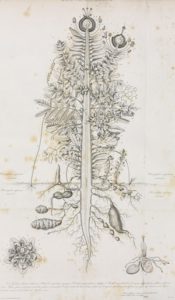 Nature. With the advent of advanced molecular techniques and tools, the detailed scrutiny of a plant’s physical attributes fell to the wayside. Focus has shifted from physiological characterization of a board range of species to detailed genomic work being done on a few select model organisms and, consequently, botany departments were forgotten and dismantled. Then came the rise of technological improvements to imaging and gene editing, such as computed tomography (CT) scanners which can create 3D reconstructions of internal plant structures without destroying tissue, and drones with laser scanners, depth sensors, and thermal imaging cameras to help improve crop breeding. These recent advances are leading to a resurgence into the areas of plant physiology, morphology, and diversity. “Welcome to Botany 2.0!” As Heidi Ledford explains, these changes in research interests leave many current molecular geneticists seeking more knowledge about botany in order to gain full appreciation and comprehension of their assays. Are you looking for more knowledge in botany? This article also highlights a program established in 2013 at the University of Connecticut- an intensive botany bootcamp. Perhaps other universities will notice the large amount of applicants applying, most of which have to be turned away, and open their own programs. (Summary by Alecia Biel) Nature. 10.1038/d41586-018-01075-5.
Nature. With the advent of advanced molecular techniques and tools, the detailed scrutiny of a plant’s physical attributes fell to the wayside. Focus has shifted from physiological characterization of a board range of species to detailed genomic work being done on a few select model organisms and, consequently, botany departments were forgotten and dismantled. Then came the rise of technological improvements to imaging and gene editing, such as computed tomography (CT) scanners which can create 3D reconstructions of internal plant structures without destroying tissue, and drones with laser scanners, depth sensors, and thermal imaging cameras to help improve crop breeding. These recent advances are leading to a resurgence into the areas of plant physiology, morphology, and diversity. “Welcome to Botany 2.0!” As Heidi Ledford explains, these changes in research interests leave many current molecular geneticists seeking more knowledge about botany in order to gain full appreciation and comprehension of their assays. Are you looking for more knowledge in botany? This article also highlights a program established in 2013 at the University of Connecticut- an intensive botany bootcamp. Perhaps other universities will notice the large amount of applicants applying, most of which have to be turned away, and open their own programs. (Summary by Alecia Biel) Nature. 10.1038/d41586-018-01075-5.
Review: Strigolactones cross the kingdoms: plants, fungi, and bacteria in the arbuscular mycorrhizal symbiosis
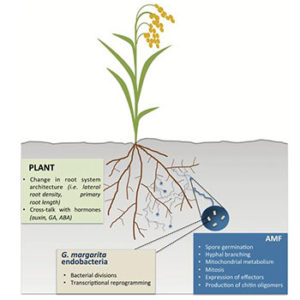 J. Exp. Bot. Strigolactones (SLs) are plant hormones with pivotal roles in plant growth. Being conserved among all plant species, they’ve been recruited by plant-associated microbes as plant-derived molecules allowing microbes to detect plants, exchange signals and establish interactions with them. In this review, Lanfranco et al. guide us along a trip following SLs in the plant, fungal and bacterial world. There is a flow of strigolactones from the roots to remote soil niches, and at each level the SLs have a different role and action. Within the plant, they regulate shoot branching and root system architecture. In the soil they are detected by arbuscular mycorrhizal fungi and stimulate hyphal branching and active metabolism. Finally, obligate endobacteria living within the mycorrhizal fungi activate a ROS burst upon detection of SLs. This review shows that SLs act as as universal coin among different kingdoms. (Summary by Marco Giovannetti) J. Exp. Bot. 10.1093/jxb/erx432
J. Exp. Bot. Strigolactones (SLs) are plant hormones with pivotal roles in plant growth. Being conserved among all plant species, they’ve been recruited by plant-associated microbes as plant-derived molecules allowing microbes to detect plants, exchange signals and establish interactions with them. In this review, Lanfranco et al. guide us along a trip following SLs in the plant, fungal and bacterial world. There is a flow of strigolactones from the roots to remote soil niches, and at each level the SLs have a different role and action. Within the plant, they regulate shoot branching and root system architecture. In the soil they are detected by arbuscular mycorrhizal fungi and stimulate hyphal branching and active metabolism. Finally, obligate endobacteria living within the mycorrhizal fungi activate a ROS burst upon detection of SLs. This review shows that SLs act as as universal coin among different kingdoms. (Summary by Marco Giovannetti) J. Exp. Bot. 10.1093/jxb/erx432
Review: 25 years of resistance (R) gene cloning identifies nine mechanisms for R protein function
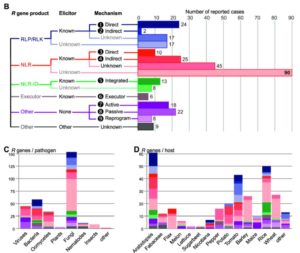 Plant Cell. Genes that confer pathogen resistance have been recognized for a very long time, and the first of these R genes was cloned 25 years ago. Kourelis and van der Hoorn examine lessons from the more than 300 R genes whose gene products are known, and from this analysis identify nine different mechanisms for their function. These nine mechanisms fall into two classes: perception and loss-of-susceptibility (see the Review for subdivisions of these two classes). The authors also summarize the different molecular structures of R proteins (e.g., NLRs, RLPs and RLKs etc.) and how these structures correlate with mechanism. This clear and well-structured review provides a useful overview of R gene functions with many specific examples of each, and would be a great paper to read with students. (Summary by Mary Williams) Plant Cell 10.1105/tpc.17.00579
Plant Cell. Genes that confer pathogen resistance have been recognized for a very long time, and the first of these R genes was cloned 25 years ago. Kourelis and van der Hoorn examine lessons from the more than 300 R genes whose gene products are known, and from this analysis identify nine different mechanisms for their function. These nine mechanisms fall into two classes: perception and loss-of-susceptibility (see the Review for subdivisions of these two classes). The authors also summarize the different molecular structures of R proteins (e.g., NLRs, RLPs and RLKs etc.) and how these structures correlate with mechanism. This clear and well-structured review provides a useful overview of R gene functions with many specific examples of each, and would be a great paper to read with students. (Summary by Mary Williams) Plant Cell 10.1105/tpc.17.00579
Update: SnRK1 kinase as a central mediator of energy signaling between different organelles
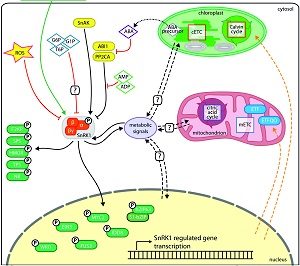 Plant Physiol. The heterotrimeric SNF1-related protein kinase 1 (SnRK1) in plants is an orthologue of yeast SNF1 (sucrose non-fermenting 1) kinase and the mammalian AMPK (AMP-58 activated protein kinase). A significant array of genetic evidence during the past years has identified SnRK1 as a key regulator of cellular metabolism during starvation and nutrient acquisition. Yet, the connections between cytoplasmic and nuclear localized SnRK1 is still unknown, and whether there is any correlation of SnRK1 with the plant energy factories like plastids and mitochondria still remains to be investigated. Wurzinger et al. have given a broad overview reflecting current knowledge of SnRK1 in organelle interaction and its mechanistic basis. The review covers the role of SnRK1 in: metabolic re-programming and hormone signalling during growth and stress, developmental transitions, and signalling to organelles by post-translational modification of transcription factors. As this review demonstrates, SnRK1 has different functions across different tissues and provides many opportunities for further research. (Summary by Amey Redkar) Plant Physiol. 10.1104/pp.17.01404
Plant Physiol. The heterotrimeric SNF1-related protein kinase 1 (SnRK1) in plants is an orthologue of yeast SNF1 (sucrose non-fermenting 1) kinase and the mammalian AMPK (AMP-58 activated protein kinase). A significant array of genetic evidence during the past years has identified SnRK1 as a key regulator of cellular metabolism during starvation and nutrient acquisition. Yet, the connections between cytoplasmic and nuclear localized SnRK1 is still unknown, and whether there is any correlation of SnRK1 with the plant energy factories like plastids and mitochondria still remains to be investigated. Wurzinger et al. have given a broad overview reflecting current knowledge of SnRK1 in organelle interaction and its mechanistic basis. The review covers the role of SnRK1 in: metabolic re-programming and hormone signalling during growth and stress, developmental transitions, and signalling to organelles by post-translational modification of transcription factors. As this review demonstrates, SnRK1 has different functions across different tissues and provides many opportunities for further research. (Summary by Amey Redkar) Plant Physiol. 10.1104/pp.17.01404
Auxin and ROP GTPase signaling of polar nuclear migration in root epidermal hair cells
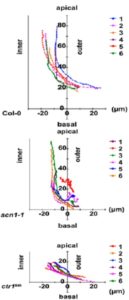 Plant Physiol. The nucleus is a dynamic organelle whose positioning and movement is highly coordinated throughout plant development and differs between cell types. Upon the initiation and subsequent elongation of root hairs, the nucleus moves from a central position to the tip of the growing root hair. Nakamura et al. investigated the mechanism behind this essential nuclear movement, focusing on the role of auxin and Rho-GTPase signaling to coordinate actin changes. The authors first noted that the nucleus moved from a central position in meristem cells to the inner epidermal plasma membrane during elongation and then to the outer domain into the emerging hair bulge. This nuclear movement was disrupted when auxin concentrations were altered and also when vacuolar development was impaired. By utilizing mutants in Rho-of-Plant (ROP) signaling, ROP activation was found to be important for inner polar nuclear positioning and, in combination with mutants impaired in auxin signaling, this ROP activation shown to act synergistically with auxin signaling. Most prominently, nuclei lose polar positioning and have decreased velocity when the actin cytoskeleton is disrupted. The study places multiple ROP and auxin signaling mediators in a pathway which further elucidates nuclei movement in root hair initiation and emergence as well as indicates a role for actin in this process. (Summary by Alecia Biel) Plant Physiol. 10.1104/pp.17.00713.
Plant Physiol. The nucleus is a dynamic organelle whose positioning and movement is highly coordinated throughout plant development and differs between cell types. Upon the initiation and subsequent elongation of root hairs, the nucleus moves from a central position to the tip of the growing root hair. Nakamura et al. investigated the mechanism behind this essential nuclear movement, focusing on the role of auxin and Rho-GTPase signaling to coordinate actin changes. The authors first noted that the nucleus moved from a central position in meristem cells to the inner epidermal plasma membrane during elongation and then to the outer domain into the emerging hair bulge. This nuclear movement was disrupted when auxin concentrations were altered and also when vacuolar development was impaired. By utilizing mutants in Rho-of-Plant (ROP) signaling, ROP activation was found to be important for inner polar nuclear positioning and, in combination with mutants impaired in auxin signaling, this ROP activation shown to act synergistically with auxin signaling. Most prominently, nuclei lose polar positioning and have decreased velocity when the actin cytoskeleton is disrupted. The study places multiple ROP and auxin signaling mediators in a pathway which further elucidates nuclei movement in root hair initiation and emergence as well as indicates a role for actin in this process. (Summary by Alecia Biel) Plant Physiol. 10.1104/pp.17.00713.
Loop Assembly: a simple and open system for recursive fabrication of DNA circuits
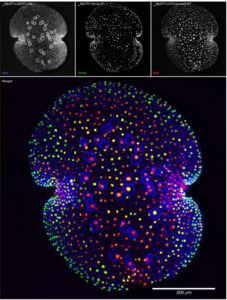 bioRxiv. Ambitious plant synthetic biology projects are driving the evolution of advanced DNA assembly techniques that permit efficient and rapid assembly of multiple transcriptional units (TUs). Pollack et al. have incorporated features of individual techniques into a single “general purpose DNA assembly system”. The system takes advantage of the standardisation of the MoClo/GoldenBraid/PhytoBricks syntax, and uses recursive digestion-ligation cycles (BsaI & SapI) to build plasmids with 16 TUs from the individual parts in three cloning reactions. The plasmids are also compatible with Gibson assembly, providing an alternative assembly pipeline. Cloned plasmids can be propagated in Agrobacterium tumefaciens and are suitable for plant transformation. In conjunction with this system, the authors outline OpenMTA, a framework for the open sharing of DNA parts without restriction on usage or redistribution which includes the Loop Assembly plasmids. In addition, the authors describe LoopDesigner, an open source software for assembly design using Loop Assembly. (Summary by Mike Page) bioRxiv 10.1101/247593
bioRxiv. Ambitious plant synthetic biology projects are driving the evolution of advanced DNA assembly techniques that permit efficient and rapid assembly of multiple transcriptional units (TUs). Pollack et al. have incorporated features of individual techniques into a single “general purpose DNA assembly system”. The system takes advantage of the standardisation of the MoClo/GoldenBraid/PhytoBricks syntax, and uses recursive digestion-ligation cycles (BsaI & SapI) to build plasmids with 16 TUs from the individual parts in three cloning reactions. The plasmids are also compatible with Gibson assembly, providing an alternative assembly pipeline. Cloned plasmids can be propagated in Agrobacterium tumefaciens and are suitable for plant transformation. In conjunction with this system, the authors outline OpenMTA, a framework for the open sharing of DNA parts without restriction on usage or redistribution which includes the Loop Assembly plasmids. In addition, the authors describe LoopDesigner, an open source software for assembly design using Loop Assembly. (Summary by Mike Page) bioRxiv 10.1101/247593
Genomes of 13 domesticated and wild rice relatives highlight genetic conservation, turnover and innovation across the genus Oryza
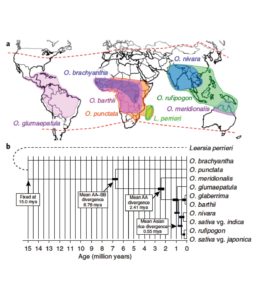 Nature Genetics. In order to use wild rice relatives for future crop improvement, the differences and similarities between wild and domesticated genomes need to be understood. Stein and colleagues sequenced the genomes of two domesticated varieties and seven wild species, unraveling 15 million years of evolutionary history driven by natural selection and human domestication. The diversity of the genome sequences imply rapid diversification rate, that enabled two domestication events. New disease resistance genes were identified in pairs facing each other head-to-head, carrying unusual C- and N-terminal domains that can enhance pathogen resistance. High turnover-rate of transposable elements not only underscores the rapid evolutionary rate of rice genomes, but also can serve an additional resource for breeding. (Summary by Magdalena Julkowska) Nature Genetics 10.1038/s41588-018-0040-0
Nature Genetics. In order to use wild rice relatives for future crop improvement, the differences and similarities between wild and domesticated genomes need to be understood. Stein and colleagues sequenced the genomes of two domesticated varieties and seven wild species, unraveling 15 million years of evolutionary history driven by natural selection and human domestication. The diversity of the genome sequences imply rapid diversification rate, that enabled two domestication events. New disease resistance genes were identified in pairs facing each other head-to-head, carrying unusual C- and N-terminal domains that can enhance pathogen resistance. High turnover-rate of transposable elements not only underscores the rapid evolutionary rate of rice genomes, but also can serve an additional resource for breeding. (Summary by Magdalena Julkowska) Nature Genetics 10.1038/s41588-018-0040-0
Cytokinin regulation in the endoplasmic reticulum
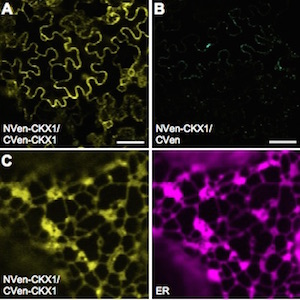 Plant Physiol. Cytokinin is a phytohormone involved in many plant processes such as cell proliferation, apical dominance, leaf senescence, tissue patterning, organ initiation, environmental responses… To allow for effective control of all these processes, cytokinin concentrations need to be continuously adjusted.
One such control mechanism is the irreversible degradation of cytokinin controlled by CKX (cytokinin oxidase/dehydrogenase) enzymes. Little is known about these proteins’ molecular behaviour and cellular localization. In Arabidopsis thaliana they are encoded by a small gene family of just 7 members. Nieman et al. show that one of them, CKX1, is a type-II integral membrane protein in the endoplasmic reticulum (ER) that forms homooligomeric complexes. According to their results, the N-terminal section of CKX1 is the one responsible for targeting to the ER and, together with the transmembrane domain, responsible for the homooligomerization. (Summary by Isabel Mendoza) Plant Physiol. 10.1104/pp.17.00925
Plant Physiol. Cytokinin is a phytohormone involved in many plant processes such as cell proliferation, apical dominance, leaf senescence, tissue patterning, organ initiation, environmental responses… To allow for effective control of all these processes, cytokinin concentrations need to be continuously adjusted.
One such control mechanism is the irreversible degradation of cytokinin controlled by CKX (cytokinin oxidase/dehydrogenase) enzymes. Little is known about these proteins’ molecular behaviour and cellular localization. In Arabidopsis thaliana they are encoded by a small gene family of just 7 members. Nieman et al. show that one of them, CKX1, is a type-II integral membrane protein in the endoplasmic reticulum (ER) that forms homooligomeric complexes. According to their results, the N-terminal section of CKX1 is the one responsible for targeting to the ER and, together with the transmembrane domain, responsible for the homooligomerization. (Summary by Isabel Mendoza) Plant Physiol. 10.1104/pp.17.00925
Chemical hijacking of auxin signaling with an engineered auxin–TIR1 pair ($)
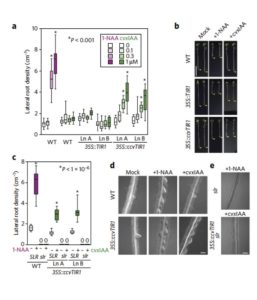
Nature Chem. Biol. Gene redundancy and/or developmental defects of higher order mutants make it hard to study the role of individual components of auxin signaling. Structural biology approach can provide a detour that circumvents endogenous auxin signaling. Removing of the phenyl moiety of F79 in the auxin receptor TIR1 introduces a concavity that disables auxin binding. However, this gap can be filled if one attached a “bump” to an auxin molecule, sucy as an aryl group at the 5-position of IAA. Plants expressing concave TIR1 showed activation of auxin signaling only when treated with convex-IAA. This tool enabled Uchida and colleagues to determine TIR1-dependent auxin responses, including transcriptional responses, increases in lateral root density and acid-growth responses. The potential of this structural biology approach for other signaling pathways are yet to be explored. (Summary by Magdalena Julkowska) Nature Chem. Biol. 10.1038/nchembio.2555
Supression of phyB dark reversion by PCH1 and PCHL
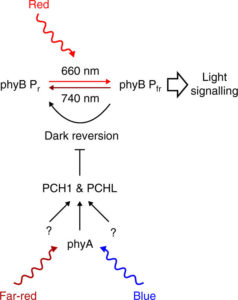 Nature Comms. Phytochromes can exist in two states: an inactive state Pr and an active state Pfr. They convert into each other by light absorption. They can also revert to the inactive state by a light-independent thermal relaxation process called dark reversion. Phytochrome B is the primary receptor for red light (R) and is strongly affected by dark reversion. Recently a new protein PCH1 (PHOTOPERIODIC CONTROL OF HYPOCOTIL 1) has been found to bind light-activated phyB. Enderle and collaborators found that a homologue PCHL (PCH1-LIKE) also bound to light activated phyB. The pch1 pchl double mutant shows an accerated phyB dark reversion. Experiments with pulses of R and FR with overexpressors of PCH1 and PCHL showed that the effect is specific for dark reversion and does not affect photoconversion. Overexpression of PCH1 and PCHL also strongly reduced phyB dark reversion as shown by measurements of phyB active and total levels. (Summary by Cecilia Vasquez-Robinet) Nature Comms. 10.1038/s41467-017-02311-8
Nature Comms. Phytochromes can exist in two states: an inactive state Pr and an active state Pfr. They convert into each other by light absorption. They can also revert to the inactive state by a light-independent thermal relaxation process called dark reversion. Phytochrome B is the primary receptor for red light (R) and is strongly affected by dark reversion. Recently a new protein PCH1 (PHOTOPERIODIC CONTROL OF HYPOCOTIL 1) has been found to bind light-activated phyB. Enderle and collaborators found that a homologue PCHL (PCH1-LIKE) also bound to light activated phyB. The pch1 pchl double mutant shows an accerated phyB dark reversion. Experiments with pulses of R and FR with overexpressors of PCH1 and PCHL showed that the effect is specific for dark reversion and does not affect photoconversion. Overexpression of PCH1 and PCHL also strongly reduced phyB dark reversion as shown by measurements of phyB active and total levels. (Summary by Cecilia Vasquez-Robinet) Nature Comms. 10.1038/s41467-017-02311-8
Nutrient modulation of Arabidopsis shoot apical meristem dynamics
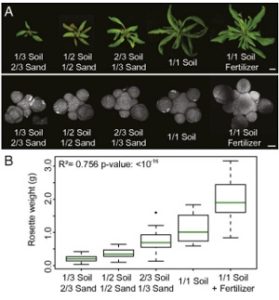 Proc. Natl. Acad. Sci. USA. The shoot apical meristem (SAM) is essential for the adaptation of aerial plant tissue architecture to changes in the environment. This paper by Landrein and colleagues connects changes in the plant environment (soil type, soil fertility, nitrate concentration) to changes in the SAM, using quantitative microscopy, grafting experiments, and mutant studies in Arabidopsis thaliana. This connection is due to the systemic signal of cytokinin precursors that mediate changes in SAM size and organogenesis rate due to the availability of nutrients. These changes take place through the modulation of WUSCHEL expression, a transcription factor that is key regulator for stem cell homeostasis. For example, the SAM adapts to changes in nitrate concentration by modulating the rate of organ production. This study connects the stem cell regulatory network (i.e. WUSCHEL) to SAM function and adaptation to the environment. (Summary by Julia Miller) Proc. Natl. Acad. Sci. USA. 10.1073/pnas.1718670115
Proc. Natl. Acad. Sci. USA. The shoot apical meristem (SAM) is essential for the adaptation of aerial plant tissue architecture to changes in the environment. This paper by Landrein and colleagues connects changes in the plant environment (soil type, soil fertility, nitrate concentration) to changes in the SAM, using quantitative microscopy, grafting experiments, and mutant studies in Arabidopsis thaliana. This connection is due to the systemic signal of cytokinin precursors that mediate changes in SAM size and organogenesis rate due to the availability of nutrients. These changes take place through the modulation of WUSCHEL expression, a transcription factor that is key regulator for stem cell homeostasis. For example, the SAM adapts to changes in nitrate concentration by modulating the rate of organ production. This study connects the stem cell regulatory network (i.e. WUSCHEL) to SAM function and adaptation to the environment. (Summary by Julia Miller) Proc. Natl. Acad. Sci. USA. 10.1073/pnas.1718670115
Network-guided discovery of transcription factors epistasis in glucosinolate biosynthesis
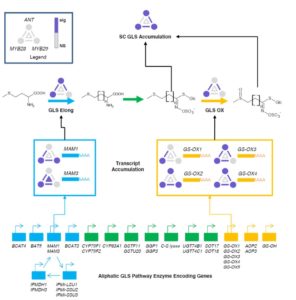 Plant Cell. Li et al. studied epistatic (non-additive) interactions amongst the network of transcription factors controlling aliphatic glucosinolate biosynthetic pathways, which are well-described and have diverse roles in plant defense. Specifically, the authors measured metabolite levels and transcript abundance in combinations of double mutnats of 20 transcription factors involved in glucosinolate production. They found that epistatic interactions were common in this network, and that some of the genes with the smallest effect as single mutants showed the greatest epistatic effects. They also found that the observed epistatic effects differed between different tissues and when the output being measured was transcript or metabolite. (Summary by Mary Williams). Plant Cell 10.1105/tpc.17.00805
Plant Cell. Li et al. studied epistatic (non-additive) interactions amongst the network of transcription factors controlling aliphatic glucosinolate biosynthetic pathways, which are well-described and have diverse roles in plant defense. Specifically, the authors measured metabolite levels and transcript abundance in combinations of double mutnats of 20 transcription factors involved in glucosinolate production. They found that epistatic interactions were common in this network, and that some of the genes with the smallest effect as single mutants showed the greatest epistatic effects. They also found that the observed epistatic effects differed between different tissues and when the output being measured was transcript or metabolite. (Summary by Mary Williams). Plant Cell 10.1105/tpc.17.00805
Where do all the ecologists go? An investigation of US Doctorate recipients
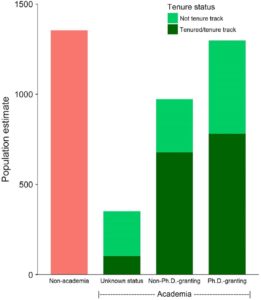 Ecosphere. Hampton and Labou investigated the employment figures for recent recipients of PhDs (degree awarded between 2000 and 2011) in ecology from US-based institutions. They found that less than 20% of the PhD recipients are in tenure-track positions at research-focused, PhD-granting universities. Similar numbers were on the tenure track of non-PhD granting institutions, or in non-tenure track positions including research assistant, project manager or teaching. The authors point to several ways that graduate students should prepare themselves for these various employment opportunities, including engaging in activities that will enable them to demonstrate “interpersonal and project management skills” including outreach, communication, program leadership, and fundraising. This is a good paper for those at the giving or receiving end of graduate training. (Summary Mary Williams) Ecosphere. 10.1002/ecs2.2031
Ecosphere. Hampton and Labou investigated the employment figures for recent recipients of PhDs (degree awarded between 2000 and 2011) in ecology from US-based institutions. They found that less than 20% of the PhD recipients are in tenure-track positions at research-focused, PhD-granting universities. Similar numbers were on the tenure track of non-PhD granting institutions, or in non-tenure track positions including research assistant, project manager or teaching. The authors point to several ways that graduate students should prepare themselves for these various employment opportunities, including engaging in activities that will enable them to demonstrate “interpersonal and project management skills” including outreach, communication, program leadership, and fundraising. This is a good paper for those at the giving or receiving end of graduate training. (Summary Mary Williams) Ecosphere. 10.1002/ecs2.2031



